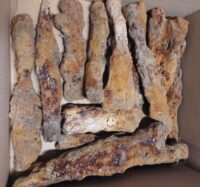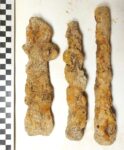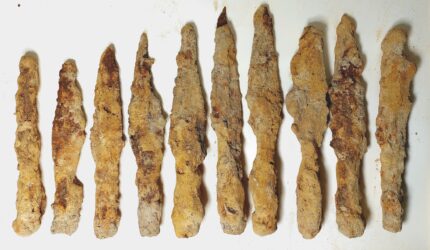 A hoard of iron weapons has been discovered in the state forest outside Hrubieszów, Poland, near the border with Ukraine. Forester Mateusz Filipowicz and some friends came across the iron objects earlier this month. In marshy area that had been disturbed by heavy forestry machinery and animal activity, they saw a rusty, mud-covered object they could not identify. They dug a small hole to remove the object and found more than a dozen additional iron objects just as filthy and heavily corroded.
A hoard of iron weapons has been discovered in the state forest outside Hrubieszów, Poland, near the border with Ukraine. Forester Mateusz Filipowicz and some friends came across the iron objects earlier this month. In marshy area that had been disturbed by heavy forestry machinery and animal activity, they saw a rusty, mud-covered object they could not identify. They dug a small hole to remove the object and found more than a dozen additional iron objects just as filthy and heavily corroded.
Because the artifacts were caked in sand, mud and corrosion materials, they couldn’t tell what the objects were at first glance. They took the group to a garage to clean them and hopefully determine what they might be. They expected they’d found some random twisted metal from World War II, but as soon they rinsed them off, they realized they were much older archaeological materials and immediately reported the objects and find site to the director of the Museum of the Priest Stanisław Staszic in Hlubieszów.
 Two hours later, they dropped off the artifacts at the museum in a mushroom basket. Museum director Bartłomiej Bartecki examined the contents of the basket and determined it contained nine iron spearheads, two iron battle axes, one blade axe, one iron shield holder and two iron points or chisels. It had to have been collected and deliberately deposited in antiquity, likely during the Roman imperial period.
Two hours later, they dropped off the artifacts at the museum in a mushroom basket. Museum director Bartłomiej Bartecki examined the contents of the basket and determined it contained nine iron spearheads, two iron battle axes, one blade axe, one iron shield holder and two iron points or chisels. It had to have been collected and deliberately deposited in antiquity, likely during the Roman imperial period.
No assemblage like this has ever been found in the Hrubieszów region before. Iron weapons have only been found in the graves of Germanic and Vandal peoples, and those were individual pieces interred as grave goods. The find site shows no evidence of a burial, no bones, no pottery, only weapons. This means someone brought an organic container full of iron weapon pieces to the ancient marsh and deposited them there. The container survived long enough to keep them together in a single group before decomposing.
 It’s possible that the iron hoard was deposited by Goths. Unlike the other peoples who inhabited the area in antiquity, the Goths did not bury iron weapons and tools in graves, even though they certainly used them just like everyone else. If they were “retiring” them by depositing them in swamps, that would explain the paucity of iron at Gothic sites in Poland.
It’s possible that the iron hoard was deposited by Goths. Unlike the other peoples who inhabited the area in antiquity, the Goths did not bury iron weapons and tools in graves, even though they certainly used them just like everyone else. If they were “retiring” them by depositing them in swamps, that would explain the paucity of iron at Gothic sites in Poland.
The objects are currently undergoing conservation at the Museum of the Priest Stanisław Staszic to reveal their true visages under all the rust and crust. Archaeologists will return to the find site for a follow-up excavation in the spring.

As far as Germany is concerned, Roman battle sites are hard to find:
What is referred to as the ‘events on the Harzhorn’ took place at a much smaller scale some 200 years after the Battle of the Teutoburg Forest around the campaigns of Germanicus until 16 AD.
What makes it particularly complicated: Germanic tribes of the time were sometimes equipped with Roman weaponry, and of all the 214 projectiles (out of 3000+ artifacts) only one ornamented spearhead of 20cm clearly identified as being Germanic.
…Thus, let us see what is hiding under the crust!
It is nice how many archaeological finds in my area you have here.
🙂